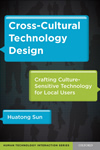 A review of
A review of
Cross-Cultural Technology Design: Creating
Culture-Sensitive Technology for Local Users
by Huatong Sun
Oxford University Press
Increasingly, the work of user experience is global. There aren’t many websites, online services, or apps that don’t cross at least a few cultural or national boundaries. Even websites intended for a local audience can be used by anyone around the world and adapted for local use by people in different contexts and cultures.
This creates a design challenge that is difficult to solve with a few guidelines and patterns. In Cross-Cultural Technology Design, Huatong Sun takes a broader view by examining the challenge of understanding cultural expectations and local context. This is not a how-to book offering guidelines and tips. It is (as Sun says in the preface) a scholarly work, primarily intended for an academic audience; however, it’s well worth the time of any practitioner interested in cultural issues in design.
If you are intrigued by contemporary theoretical debates, the first section of the book is a review of the theoretical underpinnings of Sun’s work, including activity theory, British cultural studies, and genre theory.
If you are more comfortable with the concrete, start with the middle section, “Experiences,” which contains five stories of how people use mobile communications. These case histories are rich with detailed observations collected over several years. They include Sophie, an American business professional; Lili, a Chinese teacher; Brian, an American graduate student; Mei, a Chinese graduate student; and Emma, an American college student.
Their stories carefully unpack the way their social and cultural context affects their user experience of using text messaging in different ways, including how, when, why, and with whom they choose to communicate. Each story ends with the author’s reflections on what the case study reveals about cross-cultural design. Instead of deriving design rules from these case studies, Sun offers a framework for a design philosophy for making technology usable and meaningful to culturally diverse users.
The framework, Culturally Localized User Experience (CLUE), emphasizes the need to integrate understanding of the different ways we experience technology as both actions and interpretation:
- Local culture is an ever-changing context made up of both practices and meanings.
- User experience includes both activity (situated in a context) and the meaning we assign to or construct for that activity.
- Design is both problem solving and engaged conversation.
- Technology is a tool to produce something and a means of communication due to what our choice of technology conveys.
- Affordance includes the physical design, the interaction, and the social meaning.
How people use technology, and what that technology means to them, is an ongoing conversation through which people make sense of their world. Culture is dynamic and constantly evolving, with local culture in dialog with global influences. Design must start from a full understanding of the local context and then integrate it into a larger, global view.
Do not let the somewhat academic tone of this book put you off. If you are wrestling with the challenge of global UX, this book is a thoughtful exploration of the intersection of global and local, of activity and meaning. Thinking globally, Sun suggests, requires both meanings of the word global: thinking of the different context and cultures around the world and thinking about a holistic overview in the design process.
Whitney combines a fascination with people and an obsession to communicate clearly with her work bringing user research insights to designing products where people matter. She's also passionate about elections, and leads the Center for Civic Design with Dana Chisnell. Her books are Storytelling for User Experience, GlobalUX, and A Web for Everyone. Twitter: @whitneyq and @awebforeveryone

